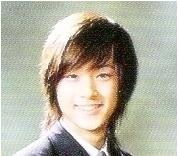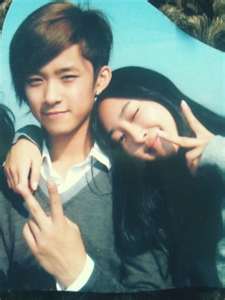well, this time i'm gonna tell you about the members.
so let's start!! kkk
1. Choi Jong Hoon (최종훈) >> @FtGtJH
The leader, guitarist, pianist and sometime vocalist kkk. he's so cute, right? >_<
he
made my heart beats so fastly when i watched A man's first love follows
him to the grave MV. he's so WOW there! he sacrificed himself for his
girl although he already knew that his girl had an affair with Hongki!
헐!
It's
Jonghoonnie's childhood pics. he was that chubby haha.. people beside
him in the third pic are his eomma and appa.
dressing as girl in JHS moment haha
and this is his mom. so pretty, right? :)
2. Lee Hong Ki (이홍기) >>
he's the main vocal of FT Island. A troublemaker, babo and crazy haha..
this is the one who made me in love with FT Island, Jeremy! eh, i mean Hongki oppa kkk
some little Hongki's pictures. i had lotsa pic of it, but they were on my stolen phone. it was being stolen in the bus when i was going to campus. i
still remember that my tears couldn't stop flowing cuz i remembered how
i brought my energy and my money to buy pulse to download FT Island's
pics and vids ㅠㅠ
Hongki oppa and his sister, Lee Ja Young (@best_ljy).
3. Lee Jae Jin (이재진) >> @saicowow
nah, finally, this is my
bias! this black goat made me crazy since the beginning of December
2010. i love the way he plays the bass, his voice and his baboness
hahaha..
see? see?? he's extra cute, right??? >__<
어머!!! baby Jaejinnie is so adorable......
some JJ'ss childhood pics.. LOL at the 3rd pic XD
and this one is JJ's pic at yearbook
Jaejinnie
with his noona Lee Jae Kyung aka Lee Chae Won (@loezve22). Jaejinnie
ain't a pretty boy when he's beside his noona haha
a happy family! JJ, his noona and his appa..
note: i just changed his twitter username cause he's just back to twitter a few days ago after 2 years ago (if i'm not mistaken it was 121209, not sure tho kkk) deleted it
4. Choi Min Hwan (최민환) >> @FtDrMH1111
The cutest drummer EVER!! the one and only drummer who's crazy over chicken. yeah, chicken! haha
look at his perfect smile!! ahhh >_<
this is Minari's predebut pic. as cute as after the debut kkk
baby minariiiiii... :D
5. Song Seung Hyun (송승현) >> @chungxuan
The
one and only guitarist who has the best smile, yup, he is Songsari..
the 16 Dimension, the one who can make you laugh because of his
weirdness XD
Seunghyun and his lil brotha, Sehyun. who's the cutest, Pris?? kkk
little songsari.. owwwwhhhh so cuteeee >.<
Former Member : Oh Won Bin (오원빈) >> @osh_yoru
Wonbinnie... i miss him so much ㅠㅠ
he left FT Island on 28 January 2010. he decided to be a solo singer, so yeah, i have to respect his decision, whatever it is.
Wonbinnie predebut for all The Way ^^
Well, could i still call his fans The Way since he's no longer under FnC? :/
Bonus
FT Island's predebut pic. have fun! kkk















































